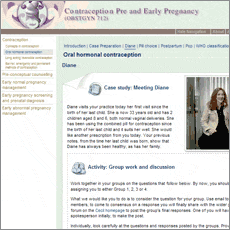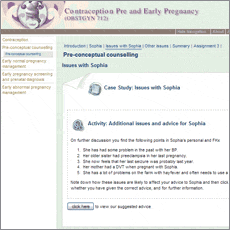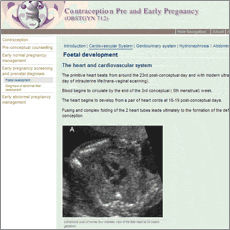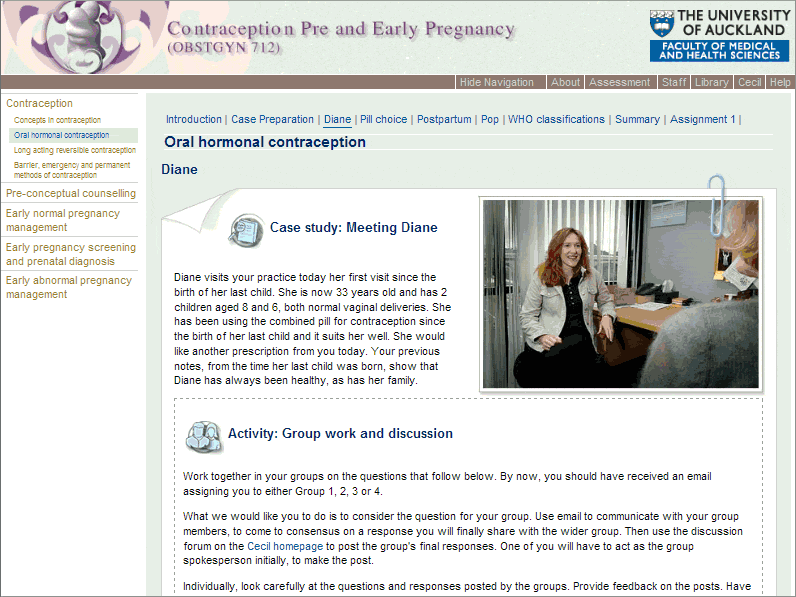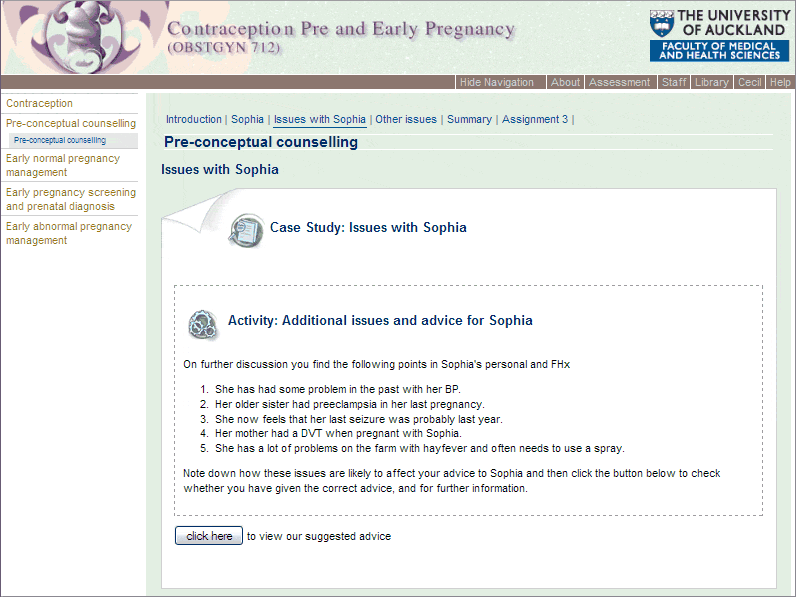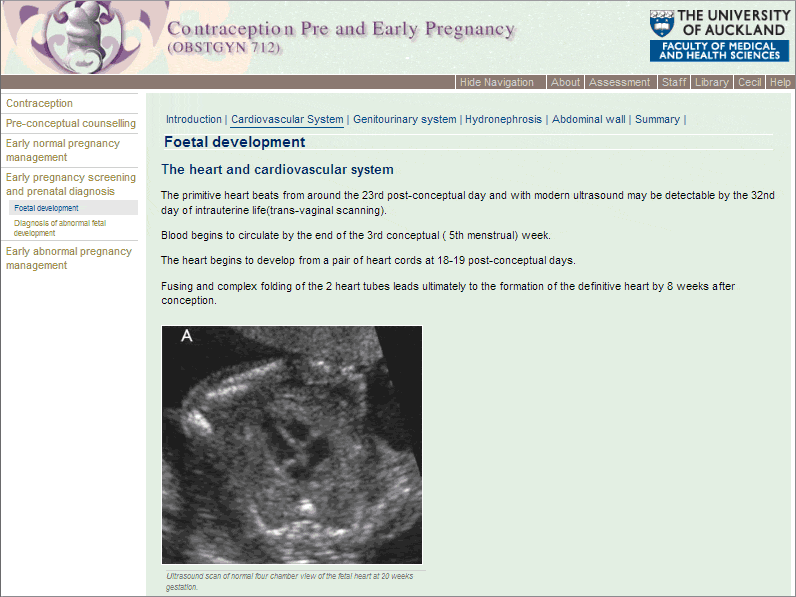Teaching online - Contraception, Pre and Early Pregnancy
Why did we decide to 'go online'?
Having to attend regular audio-conferencing sessions at set times and place was becoming more and more difficult for our student group as most of them were also working in hospitals.
We wanted to maintain the high level of interaction between students and consultants around cases that we had in the audio-conferences.
Teaching staff wanted to broaden the student group to include GPs, midwives and nurses from a wider geographic area.
Teaching resources needed updating.
What's been achieved?
Nurses, doctors and midwives now learn together and share different perspectives, resources and ideas.
Students are still required to maintain a schedule of work throughout the semester of study but they can now access learning materials at any time, from any place, affording greater flexibility.
The case scenarios are now presented online and discussion takes place on discussion forums (within Cecil). Students have more time to reflect on their responses to questions so discussion tends to be well thought out and includes reference to theory and research in a way that in-class discussion doesn't always allow for. Staff report that students also engage more with each other about the case questions.
Helen Roberts talks about learning online.![]() click here to play the video (requires Flash Player).
click here to play the video (requires Flash Player).
Images including photos, ultrasound scans, xrays and other graphics have been updated and offer a much higher quality of presentation. Students are able to watch video enactments which portray the affective side of clinical practice and offer the opportunity for critique and reflection. They can also access interviews with experts in the area and through online discussion explore related practice issues.
Lessons learned - facilitating online discussion
It is hugely important to interact with the students. They can't just be left on their own. They actually need a lot of feedback. When the teaching staff are interactive, the online discussion is also likely to be active and enthusiastic.
Also, someone needs to make sure each year that information, readings and web links are updated - this may seem self evident but there is a temptation to think once material is ‘up there' it doesn't need any further work!
4th September
Hi everyone and a warm welcome to Week 8 - "Early Normal Pregnancy".
My name is Paul Cohen and I am a Lecturer in the Department of O&G at the University of Auckland. I will be facilitating the 712 Diploma Course for the next few weeks.
If anyone has any questions that they would prefer not to ask on the discussion boards then please feel free to contact my by e-mail at p.cohen@auckland.ac.nz
This week covers some fundamental background maternal physiology and embryology and it is essential to have a good understanding of these in order to appreciate the 'abnormal' which will be covered in subsequent weeks.
I look forward to your answers and comments and I will post on the discussion board again later in the week.
With best wishes,
Paul.
9th September
Hi everyone.
Some excellent (and very common) questions from Group 3 about ailments in early pregnancy.
Group 1 should answer these questions and then pose some questions of their own for group 3 to answer.
Groups 1 and 2 - it's a good idea not to leave this too long otherwise you'll be thinking up really difficult questions (you're not allowed to repeat questions which the other groups have asked!!).
Kind Regards
Paul
11th September
Thanks for your questions Ruth!
I look forward to seeing Group 1's answers to these.
Remember that all of you have until the end of next Monday to post your answers/comments/questions for this week.
I'll post some final comments next Tuesday 15th Sept.
Kind Regards
Paul
15th September
Thanks very much to all of you who have posted and been involved in answering questions with your group - there are some really excellent answers. I have made some specific comments below.
Lucy and group 3: answers to group 2's questions: I like the way you have answered these questions as if you were talking to a patient. Your explanation of increased frequency/new onset of fainting is good. Don't forget about compression of the vena cava from lying supine as a cause of syncope, which is why pregnant women are advised not to lay flat on their backs. Good explanation of the increased pro-thrombotic risk in pregnancy - why do you think the increased pro-thrombotic state has arisen from an evolutionary perspective?
Francis and group 1: answers to group 3's questions: These were answered very thoroughly and display an excellent knowledge of pregnancy physiology and of the pathophysiology of common pregnancy ailments. Your answer to question 5 regarding "why do my feet swell?" is partly correct but one of the key factors is the reduction in plasma oncotic pressure (because of the increased plasma volume without a compensatory increase in plasma proteins) which results in a decrease in movement of water from the tissues back into the capillaries/circulation by osmosis. This is exacerbated by the capillary leak.
You have given some interesting alternative strategies for nausea and vomiting in pregnancy - is there evidence to support any of them?
Sharee and group 4: Excellent answer to the question about exercise. Regarding "benign" heart murmurs - I think the question is a little confusing (not your fault!). If we know the murmur is truly benign (presumably because the woman has been diagnosed previously and has had an echocardiogram) then she has nothing to be concerned about as the murmur will be a flow murmur (most commonly a pulmonary arterial flow murmur). You should all know the clinical features of a "benign" murmur and the clinical features of a murmur which should make you suspicious of a valvular lesion and prompt an echo. There is a very simple and effective clinical examination manoeuvre which makes flow murmurs become quieter or disappear completely, whereas murmurs due to structural lesions will not change. Does anyone know what this is?
Group 2 - did you post?
Kind Regards
Paul
Now listen to Dr Helen Roberts talking about facilitating discussion online:
Who was involved?
Dr Helen Roberts, Dr Emma Parry, and Professor Peter Stone wrote the study materials for the course.
The CAD eLearning Group provided assistance with learning design, web and graphic design, photography and video production.
The Librarians from Philson Library were also involved in ensuring reading resources were available and copyright issues addressed.
What do students say about it?
"Web based course brings up more issue of discussion, as people are able to contribute anytime they wish about anything. Unlike audio conference - only 2 hours allocated."
"This was my first online course so can't compare to others but I would do it again. I would say the time spent was about right as there was quite a lot to get through with the reading, discussion forums, assignments and portfolio entries."
Edit page




